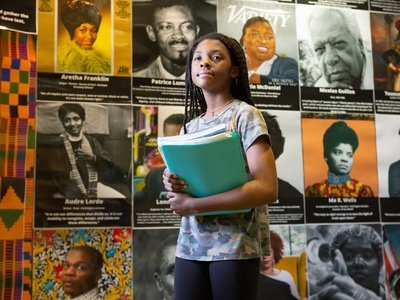New Designs for School
Reading Between the Texts: SEL Strategies for Navigating the Digital Maze
Topics
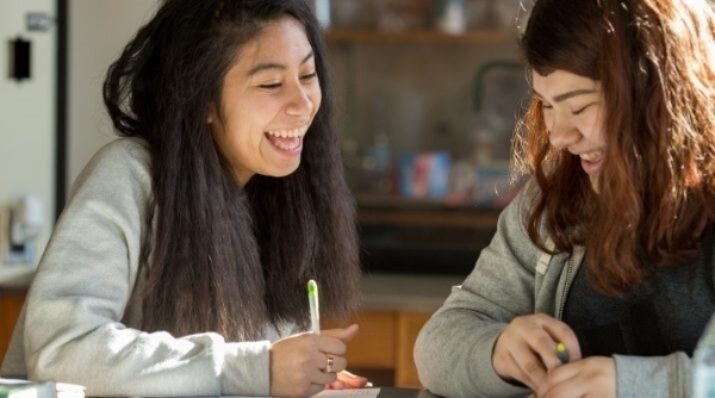
We’ve all had the experience of truly purposeful, authentic learning and know how valuable it is. Educators are taking the best of what we know about learning, student support, effective instruction, and interpersonal skill-building to completely reimagine schools so that students experience that kind of purposeful learning all day, every day.
Schools can teach students digital communication strategies to help them decode intent, handle misunderstandings, and collaborate effectively.
Today’s students are not just digital natives—they’re digital decision-makers. They communicate more through texts, direct messages, and social media than face-to-face conversations.
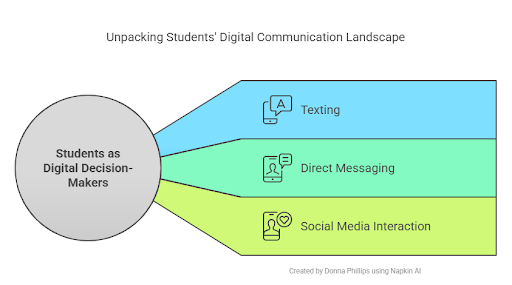
Yet, despite this shift, embedding digital communication strategies into academic curricula has not always been a smooth transition. While conflict resolution is still often taught with a face-to-face focus, this presents a significant opportunity to integrate SEL (Social-Emotional Learning) and SEAD (Social, Emotional, and Academic Development) into all classes. SEAD emphasizes the integration of academic learning with the development of emotional intelligence, social responsibility, and ethical behavior, which is critical in today's interconnected world (CASEL, n.d.). By teaching students how to decode digital intent, pause before reacting, and handle misunderstandings with empathy, we prepare them for the challenges of the digital world and help them develop the critical skills they need to thrive as collaborators and leaders—both online and in person.
Learning the Pause: Master the Moment
This isn’t a rare situation—it happens almost every week. A student walks up to me, visibly upset, withdrawn, and looking for reassurance. Sometimes, it starts with a sigh, and other times, they’re already shutting down—head on their desk, disengaged, and not acting like themselves.
One day, it was a simple "Fine" received as a text message. Another time, it was a message left as read without a reply. Then, it was just this one word “great” as a comment on a social media direct message.
In each of these cases, the student interprets the response negatively, assuming the worst, even though no evidence supports it. Without any emotion, contextual clues, or additional expression, the message leaves them uncertain about the sender’s intent. The absence of punctuation or emotional cues, like emojis, makes it easy to misinterpret the tone and create unnecessary worry which stays with them through the day and they can’t focus on anything else.

This time, the student hesitated and handed me their phone. “I don’t get it. Look.” I glanced at the screen.
Sure
Just one word. No punctuation, no emojis. Just “sure.” To them, the message seemed cold—leaving them wondering if the other person was annoyed or upset. But when we took a moment to examine the relationship context, along with past interactions, the student realized there was no solid reason for the distress. It was simply a gut reaction to the text’s neutrality. The lack of emotional nuance in the message made it harder to interpret, but it didn’t necessarily indicate frustration or rejection.
This is where emotional regulation comes in—students must pause and shift from System 1 thinking, which is fast and reactive, to System 2 thinking, which is slower and more deliberate. By moving into System 2 thinking, students can better decode digital messages with more clarity and avoid reacting impulsively. This step directly ties to SEAD by integrating self-regulation and critical thinking—skills that help students manage their emotions and respond thoughtfully (Phillips, 2025; TeachingTimes, 2025).
Transforming SEL for Real-Time Communication
As digital communication becomes more pervasive, SEL must evolve to meet the digital needs of today’s students. By embedding digital conflict resolution into the SEL curriculum, we can teach students to decode digital intent, engage with empathy, and respond thoughtfully. This practice not only resolves conflicts but also fosters collaboration and leadership in a world where digital communication is an integral part of daily life. Digital citizenship plays a vital role in this, ensuring students understand how to engage in ethical, respectful behavior online. Integrating SEAD into these discussions reinforces the importance of social awareness and the development of responsible communication both online and offline.
Digital Literacy: Decoding Digital Intent
Just as we teach students to read between the lines of literature, we must teach them to read between the texts.
Students need to learn how small changes—such as punctuation, tone, or timing—can dramatically alter a message’s meaning.
Recognizing digital patterns in texts, social media comments, and emails helps students build critical thinking skills that improve their communication.
By teaching students to decode digital intent, we enhance their emotional intelligence, digital literacy, and digital citizenship, which are essential skills for navigating today’s complex communication landscape. This connects directly to SEAD principles of self-awareness and social awareness as students learn to understand their own emotional reactions to digital messages and the potential impact on others.
Teaching Clear Communication in the Digital Maze
Students often underestimate how their messages are perceived. Without face-to-face cues, digital exchanges can lead to misunderstandings and escalated conflicts. Here’s how we can guide students in creating clear and positive digital communication:
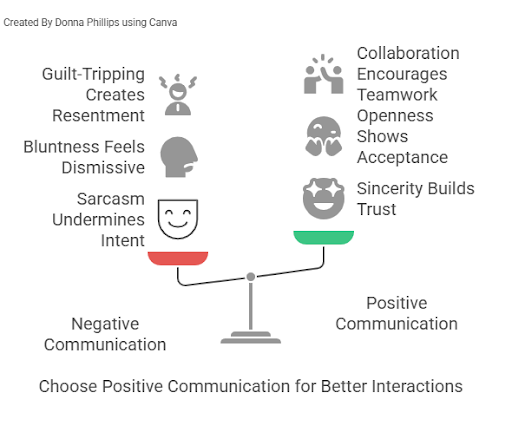
Replacing Sarcasm Tone with Sincerity
Instead of: "Wow, thanks for the reminder. That was super helpful."
Try: "Got it, thanks! Can you remind me earlier next time?"Replacing Bluntness with Openness
Instead of: "K." or "Whatever."
Try: "That works." or "I’m okay with that."Shifting from Guilt-Tripping to Collaboration
Instead of: "No worries, I’ll just do it myself."
Try: "I got this, but let’s share the next task!"Turning Frustration into Direct Communication
Instead of: "Guess I shouldn’t have expected a response."
Try: "Hey, did you get my message?"
Through these strategies, students learn to refine their digital communication and approach conversations with clarity, respect, and collaboration, which are essential for digital citizenship and conflict resolution in the digital world. These strategies contribute directly to SEAD by helping students develop positive relationship skills and collaboration techniques in an increasingly interconnected world.

The 5-5-5 Rule: Encouraging Reflection Before Reacting
The 5-5-5 Rule encourages students to pause and reflect before sending a response, particularly in digital conversations. In an age of instant communication, it’s easy to respond quickly in the heat of the moment. But this often leads to misunderstandings and escalated conflicts. The 5-5-5 Rule gives students the chance to pause, reflect, and make intentional, thoughtful decisions about how to respond.
The 5-5-5 Rule is a widely adopted strategy used in emotional intelligence and mindfulness practices. Though not specifically attributed to one individual, this technique aligns with the core principles of emotional regulation taught by experts like Daniel Goleman in his work on Emotional Intelligence and Jon Kabat-Zinn’s mindfulness practices (Goleman, 1995; Kabat-Zinn, 2005).
Here’s how the 5-5-5 Rule works:
Will this matter in 5 minutes? This question encourages students to pause and assess whether the situation is urgent or if it will lose importance with time. By considering the short-term impact, students can avoid reacting impulsively and decide whether a response is needed immediately.
Will this matter in 5 weeks? This question helps students consider the long-term impact of their reaction. Will this conversation still matter a few weeks from now, or is it just a temporary issue that will fade away? By encouraging students to think ahead, we help them avoid overreacting to fleeting moments of frustration or misunderstanding. It helps them develop patience and resilience, understanding that not every disagreement needs an immediate response.
Will this matter in 5 months or even 5 years? This final question encourages students to take a big-picture perspective. By considering whether the issue will have lasting effects on their relationships, reputation, or future goals, students learn to prioritize what truly matters.
How Does the 5-5-5 Rule Help Students?
The 5-5-5 Rule teaches students to take a moment to pause and think before reacting. It emphasizes self-awareness, emotional regulation, and critical thinking—all of which are essential for effective communication and conflict resolution. By applying this rule, students become more mindful, intentional, and strategic in their responses, leading to better outcomes in both personal and professional contexts. This directly connects with the SEAD competencies, which emphasizes emotional awareness, self-regulation, and problem-solving.
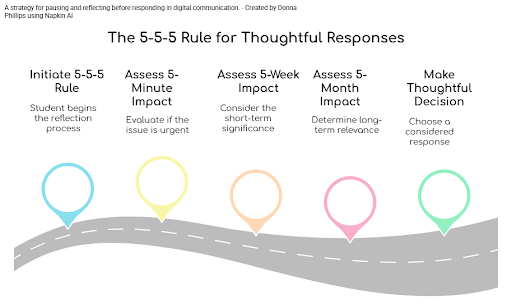
Reflection Questions for Educators: Through the Lens of Future Success
What digital conflicts have you noticed, and how could decoding intent or pausing help resolve them?
How can the 5-5-5 Rule prepare students for long-term digital success?
What opportunities do you have to integrate digital communication skills alongside traditional conflict resolution strategies?
How can teaching students about formal communication improve their future success?
How can you ensure your classroom strategies help students thrive in both digital and face-to-face communication?
Key Takeaways for Educators
Teach students to pause before reacting using the 5-5-5 Rule for better digital communication.
Reframe unclear or frustrated messages to encourage more collaborative and positive exchanges.
Help students adapt their language for different contexts to ensure they succeed in both informal and formal settings.
Integrate SEL practices into digital communication for better conflict resolution and collaboration.
Call to Action: Make SEL Digital Practices a Seamless Part of Your Classroom
Instead of adding extra work, these small, simple practices can be easily woven into your daily routine to help students develop essential digital communication skills while giving them the chance to reflect and build self-awareness. Here's how you can incorporate them into your subject area:
- Opening Quickwrite (Start of Class): Begin each class with a short, optional quickwrite. Ask students to reflect on how their digital communication might look in your subject area.
For English/Language Arts: Have them think about how they can convey tone clearly in a text or email. How could they reword a message to be clearer or better directions?
For History: Students can consider how historical figures might handle modern communication, and how they'd adjust their messages to avoid misunderstandings.
This quick activity gives them a chance to think critically and apply SEL strategies to the kinds of communication they’re working with in class.
- Morning Check-In (Start of Day): In the morning, take just a moment to check in. Ask students how they handle digital conversations, especially when things get tricky.
For Science: If they disagree with someone’s results, how can they express their thoughts digitally in a respectful way?
For Math: How do they communicate a solution clearly without causing confusion or frustration?
Giving them the space to share and reflect helps them internalize how to use their SEL skills in digital spaces.
- 5-Minute Digital Pause (Throughout the Day): Before sending any digital message—whether it's an email or a text—encourage your students to take a 5-minute pause.
For Social Studies: They can think about how their tone might come across in an online discussion.
For Art: When providing feedback to a peer’s artwork, they can ask themselves: “Am I being constructive?”
This brief pause gives them the chance to reflect and make sure their message is clear, respectful, and helpful.
- Exit Ticket Reflection (End of Class): At the end of class, use a quick exit ticket where students reflect on how they communicated during the lesson.
For Literature: How did they express their opinions about a text? Were they clear? How could they improve their message if something felt misunderstood?
For Science: How did they handle online disagreements when discussing experimental data?
By getting them to reflect on their communication, you’re helping them build awareness around the impact of their words.
These quick practices don’t require extra time but can make a huge difference. By weaving them into your class, you help students develop stronger emotional intelligence, digital literacy, and problem-solving skills. They’ll be prepared not just to communicate effectively in your subject, but also to navigate the digital world with confidence.
How will you start? Pick one of these strategies to try in your classroom tomorrow, and see the difference it can make.
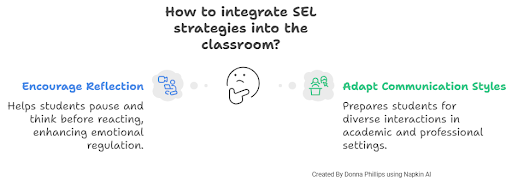
Supporting Resources
If you’d like to explore more about digital conflict resolution or SEL strategies, here are some free resources:
The Collaborative for Academic, Social, and Emotional Learning (CASEL)
Google for Education – Digital Citizenship and Safety Course and Google Education: Be Internet Awesome
References
Phillips, D. (2025). Building Resilience in Special Education: The Circle of Control. Edutopia. Retrieved from https://www.edutopia.org/article/building-resilience-special-education-circle-of-control
National Commission on Social, Emotional, and Academic Development. (2019). From a Nation at Risk to a Nation at Hope. The Aspen Institute. Retrieved from https://www.aspeninstitute.org/wp-content/uploads/2023/02/aspen_final-report_execsumm.pdf
Edutopia. (2023). SEL Resources. Retrieved from https://www.edutopia.org/social-emotional-learning
Phillips, D. (2025). What Emotional Regulation Strategies Work Best For SEND Students?. TeachingTimes. Retrieved from https://www.teachingtimes.com/what-emotional-regulation-strategies-work-best-for-send-students/
CASEL. (n.d.). What is SEL?. Retrieved from https://casel.org/fundamentals-of-sel/
Photo at top by Allison Shelley/The Verbatim Agency for EDUimages, CC BY-NC 4.0. All graphics by the author.




